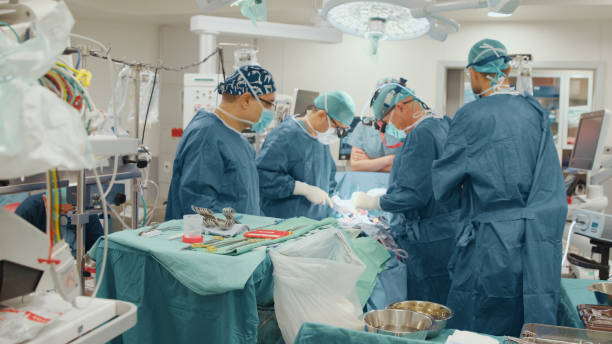Stethoscopes are vital tools in cardiac surgery, helping doctors listen to heart sounds and identify any abnormalities. Through auscultation, surgeons gain real-time insights into how the heart is functioning, which is critical during and after surgical procedures.
What is the Role of a Stethoscope in Cardiac Surgery?
In cardiac surgery, the stethoscope is used to monitor and evaluate the heart’s performance. It allows surgeons to listen to heart sounds (S1, S2, S3, S4) and detect abnormal rhythms or murmurs. This helps ensure the heart is functioning optimally during surgery and recovery. By pinpointing issues like valve malfunction or fluid buildup, doctors can make informed decisions quickly.
The 5 Key Areas for Heart Auscultation
Auscultation involves listening to specific areas of the chest where heart sounds are clearest. Each area corresponds to different parts of the heart and provides unique information.
| Area | Location | Heart Sound Heard Best |
| Aortic Area | Right second intercostal space, near the sternum | S2 (aortic valve closure) |
| Pulmonic Area | Left second intercostal space, near the sternum | S2 (pulmonic valve closure) |
| Tricuspid Area | Fourth intercostal space, left of the sternum | S1 and S2 (tricuspid valve activity) |
| Mitral Area | Fifth intercostal space, left mid-clavicular line | S1 (mitral valve closure) |
| Erb’s Point | Third intercostal space, left of the sternum | S1, S2, and abnormal heart sounds (murmurs) |
These areas are routinely assessed before and during surgery to detect irregularities in valve closure or other heart functions.
Heart Sounds: What S1, S2, S3, and S4 Mean
Heart sounds result from the opening and closing of heart valves, along with blood flow. These sounds are categorized as S1, S2, S3, and S4.

S1: The “Lub”
- Represents the closing of the mitral and tricuspid valves.
- Marks the start of systole (when the heart contracts to pump blood).
- Loudest at the mitral area.
S2: The “Dub”
- Reflects the closure of the aortic and pulmonic valves.
- Marks the end of systole and the start of diastole (when the heart relaxes to fill with blood).
- Loudest at the aortic and pulmonic areas.
S3: The Third Sound
- Heard after S2, during early diastole.
- Caused by rapid filling of the ventricles, often due to fluid overload.
- Common in children and athletes, but in adults, it can indicate heart failure.
S4: The Fourth Sound
- Occurs just before S1, during late diastole.
- Indicates stiff ventricles or reduced compliance (e.g., due to hypertension or a heart attack).
Understanding these sounds helps surgeons evaluate the heart’s efficiency and detect any anomalies.
Abnormal Heart Sounds and Their Significance
Abnormal heart sounds, such as murmurs or extra beats, can indicate underlying issues. These include:
- Murmurs: Result from turbulent blood flow due to valve problems (e.g., stenosis or regurgitation).
- Clicks: Associated with conditions like mitral valve prolapse.
- Rubs: Indicate pericarditis (inflammation of the heart’s outer layer).
Abnormal sounds are often detected using heart sounds auscultation audio for comparison with normal sounds.
How Do Doctors Perform Auscultation?
Doctors follow these steps to ensure accurate auscultation during cardiac surgery:
- Position the Patient: The patient lies flat or sits upright to enhance sound clarity.
- Quiet Environment: Background noise is minimized for better listening.
- Systematic Approach: Doctors move the stethoscope through all five auscultation areas in a specific order.
- Listen for Patterns: Focus on rhythm, pitch, and any extra sounds.
Medical students often use heart sounds and auscultation audio to practice distinguishing normal and abnormal sounds.
Comparison of Normal vs. Abnormal Heart Sounds
| Feature | Normal Heart Sounds (S1, S2) | Abnormal Heart Sounds (S3, S4, murmurs) |
| Rhythm | Regular “lub-dub” rhythm | Irregular, extra sounds |
| Duration | Short and crisp | Prolonged or harsh |
| Volume | Clear and steady | Variable; may be faint or loud |
| Indication | Healthy valve function | Valve issues, heart failure, or inflammation |
Why Is Heart Auscultation Important in Cardiac Surgery?
Heart auscultation helps detect abnormalities that may affect surgery outcomes. For example:

- Valve Malfunction: Abnormal sounds (e.g., murmurs) reveal valve stenosis or leakage.
- Fluid Overload: S3 sounds signal excess fluid, which can strain the heart.
- Heart Stiffness: S4 sounds indicate rigid ventricular walls, often linked to hypertension.
Timely identification of these issues ensures safer surgeries and better recovery outcomes.
Tools and Techniques to Improve Auscultation Skills
Practicing heart auscultation can significantly enhance diagnosis and treatment. Here are some tools and techniques:
- High-Quality Stethoscope: Invest in a device with clear sound amplification.
- Heart Sounds Simulation: Use digital tools or heart sounds auscultation audio for practice.
- Clinical Practice: Regularly perform auscultations to improve accuracy.
- Visual Guides: Charts showing the S1, S2, S3, and S4 heart sounds location help in learning.
Conclusion
The stethoscope is a cornerstone tool in cardiac surgery, enabling doctors to monitor heart sounds like S1, S2, S3, and S4. By focusing on the five auscultation areas, surgeons can detect abnormalities and address them during the procedure. Whether you’re a medical student or a patient, understanding the basics of heart sounds and auscultation can provide valuable insights into heart health.


